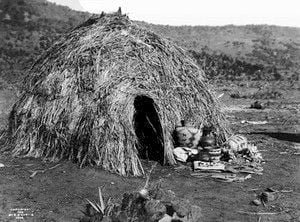
Photo by E.S, Curtis in 1892
During the late 1800s, certain bands of the Apache Indians of Arizona and New Mexico were able to tie down large numbers of United States and Mexican soldiers while living in the most primitive of dwellings the wickiup. What is particularly interesting about their huts is that its appearance was probably identical to the housing used by most Native Americans 5000 years ago. In fact, the indigenous people of New England were still living in very similar huts when the Pilgrims arrived on the Mayflower.
One can not imagine how cold those huts were in the winter. Unlike more sophisticated housing of other cultures, it was not possible to build a fire within the wickiup. The interior was too small and the entire hut was very flammable. The occupants apparently compensated by thoroughly wrapping themselves with furs, and by the time of the above photo, with Navajo blankets.
The wickiup was constructed with saplings and vines. A hemispherical frame would be woven in a manner similar to a basket. Then thatch or roof bark was attached to the frame with vines or leather thongs. The basic frame was so light weight, that some tribes living in desert regions would carry the scarce wood saplings with them when they traveled to new campsites.
